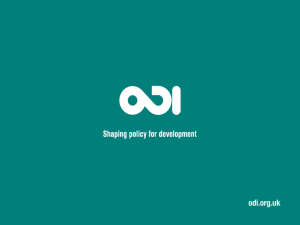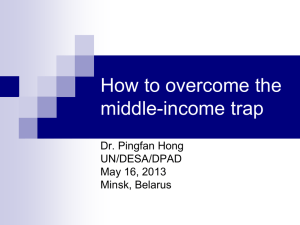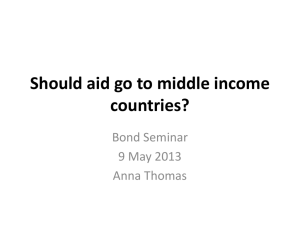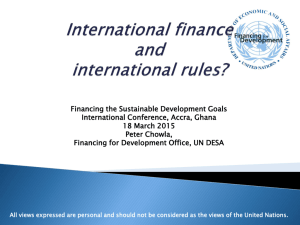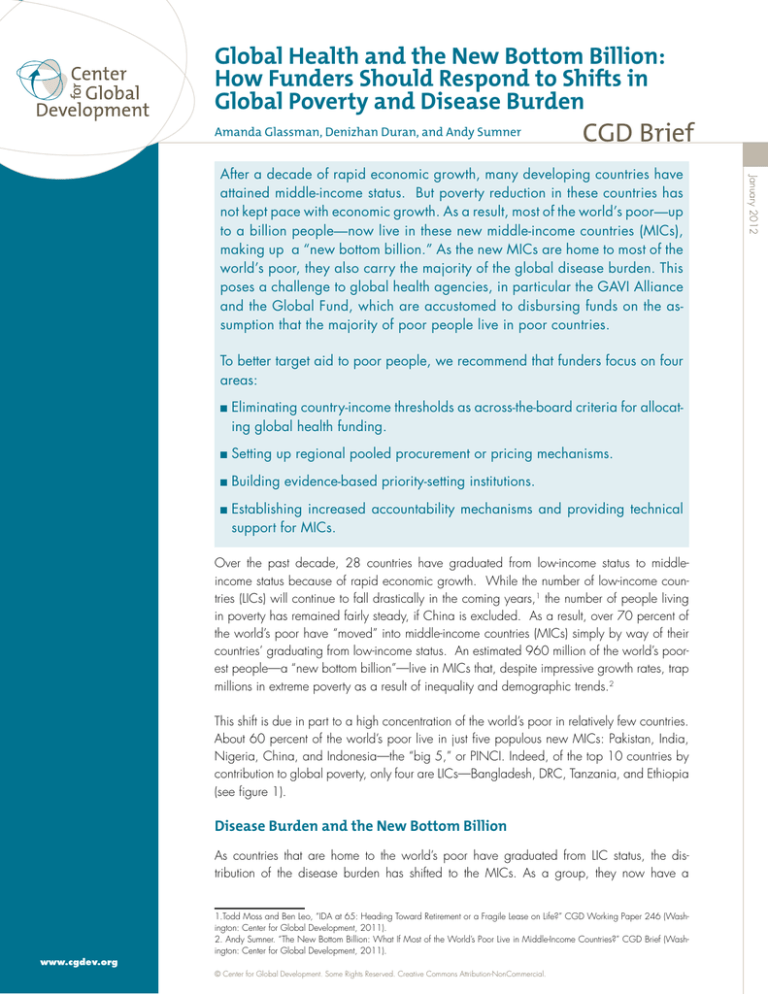
Global Health and the New Bottom Billion:
How Funders Should Respond to Shifts in
Global Poverty and Disease Burden
Amanda Glassman, Denizhan Duran, and Andy Sumner
CGD Brief
To better target aid to poor people, we recommend that funders focus on four
areas:
n Eliminating
country-income thresholds as across-the-board criteria for allocating global health funding.
n Setting
up regional pooled procurement or pricing mechanisms.
n Building
evidence-based priority-setting institutions.
n Establishing
increased accountability mechanisms and providing technical
support for MICs.
Over the past decade, 28 countries have graduated from low-income status to middleincome status because of rapid economic growth. While the number of low-income countries (LICs) will continue to fall drastically in the coming years,1 the number of people living
in poverty has remained fairly steady, if China is excluded. As a result, over 70 percent of
the world’s poor have “moved” into middle-income countries (MICs) simply by way of their
countries’ graduating from low-income status. An estimated 960 million of the world’s poorest people—a “new bottom billion”—live in MICs that, despite impressive growth rates, trap
millions in extreme poverty as a result of inequality and demographic trends.2
This shift is due in part to a high concentration of the world’s poor in relatively few countries.
About 60 percent of the world’s poor live in just five populous new MICs: Pakistan, India,
Nigeria, China, and Indonesia—the “big 5,” or PINCI. Indeed, of the top 10 countries by
contribution to global poverty, only four are LICs—Bangladesh, DRC, Tanzania, and Ethiopia
(see figure 1).
Disease Burden and the New Bottom Billion
As countries that are home to the world’s poor have graduated from LIC status, the distribution of the disease burden has shifted to the MICs. As a group, they now have a
1.Todd Moss and Ben Leo, “IDA at 65: Heading Toward Retirement or a Fragile Lease on Life?” CGD Working Paper 246 (Washington: Center for Global Development, 2011).
2. Andy Sumner. “The New Bottom Billion: What If Most of the World’s Poor Live in Middle-Income Countries?” CGD Brief (Washington: Center for Global Development, 2011).
www.cgdev.org
© Center for Global Development. Some Rights Reserved. Creative Commons Attribution-NonCommercial.
January 2012
After a decade of rapid economic growth, many developing countries have
attained middle-income status. But poverty reduction in these countries has
not kept pace with economic growth. As a result, most of the world’s poor—up
to a billion people—now live in these new middle-income countries (MICs),
making up a “new bottom billion.” As the new MICs are home to most of the
world’s poor, they also carry the majority of the global disease burden. This
poses a challenge to global health agencies, in particular the GAVI Alliance
and the Global Fund, which are accustomed to disbursing funds on the assumption that the majority of poor people live in poor countries.
Figure 1: Concentration of the world’s poor, top 10
countries, $1.25 a day, 2007
percentage of world poor
40
35
30
25
20
15
10
5
DR
C
Tan
zan
ia
Eth
iop
ia
Pak
ista
n
Vie
tna
m
Ba
ng
lad
esh
Ind
on
esi
a
Nig
eri
a
Ind
ia
Ch
ina
0
Source: Kanbur and Sumner (2011).
larger disease burden than LICs, in general and for specific diseases. The MIC disease burden is especially higher
for vaccine-preventable diseases, but also for HIV/AIDS
and tuberculosis. This disease burden is concentrated
among the PINCI but is still significant in the non-PINCI
lower-middle-income countries (LMICs) as well as—more surprisingly—the upper-middle-income countries (UMICs) in the
case of HIV/AIDS.
The shift in disease burden to MICs is driven mainly by
population size but also by lagging effort from the public
health programs that prevent or control disease. The share
of children who have received full childhood inoculations
Figure 2: Total burden of disease (DALY), all causes,
2004 (billions)
disability-adjusted life years
Global Health and the New Bottom Billion: How Funders Should Respond to Shifts in Global Poverty and Disease Burden
2
1.2
1.0
0.8
0.6
0.4
0.2
0
Low
income
Lower
middle
income
PINCIs
Upper
middle
income
Total
MIC
High
income
Source: World Health Organization Global Disease Burden Database, 2008.
Note: Lower-middle-income and upper-middle-income categories do
not include PINCI, which are shown separately. “Total MICs” includes
all categories: lower middle income, upper middle income, and
PINCIs.
(the complete vaccination rate) is lower in many MICs than
LICs. According to household survey data in 20 LICs and
17 LMICs, 42 percent of children under age five, on average, are fully vaccinated in LMICs versus 55 percent in
LICs. Administrative data, generally considered to be of
poorer quality than household survey data, provide a more
encouraging picture but are still consistent with the patterns
observed in household data. Beyond this, new vaccines that
are often available in LICs, such as those against rotavirus,
pneumococcal disease, and Hib, have yet to be introduced
in many MICs.3 Poor people in MICs also have greater
difficulty accessing lifesaving HIV treatment than their LIC
counterparts (see figure 2).
Global health agencies may have accentuated these patterns by favoring LICs in their funding allocations. In 2009,
46 percent of total health aid from Development Assistance
Committee donors was directed to LICs, whereas 39 percent was directed to LMICs and 14 percent was directed
to UMICs.4
Further, current health aid correlates poorly to disease burden. Some global health agencies, such as the GAVI Alliance, have set eligibility thresholds based on national
income, which progressively disqualifies LMICs regardless
of disease burden. In 2000, 72 countries were eligible
for GAVI assistance; now 56 countries are eligible. Under
GAVI’s current policy, only 42 countries—half of the currently
eligible population—will qualify for GAVI support by 2020.5
Donors seeking to improve health equity have no choice but
to work in MICs, where most of the world’s at-risk populations live. Health aid funding, like other aid, should respond to need, defined in this case as disease burden or
size of at-risk populations, adjusted for the fiscal capacity
of the recipient. Global health funders want to assure that
cost-effective health technologies reach the poor, but, as we
have seen, the LIC category is no longer a good proxy for
the poor, nor is average income a good measure on which
to base decisions about affordability or differential pricing
structures since there is an extremely high concentration of
wealth in MICs.6
3. WHO, Global Burden of Disease Database (Geneva, 2008).
4. OECD, CRS Database (Paris, 2009).
5. GAVI’s population drops from 328.6m in 2010 to 155.9m in 2020 (UN Population Forecasts; authors’ analysis). We base our per capita income analysis on the IMF
World Economic Outlook report until 2015, and extrapolate until 2020 by using the
average predicted economic growth rate from 2010 to 2015.
6. Prashant Yadav, “Differential Pricing for Pharmaceuticals” (London: DfID, 2010),
http://www.dfid.gov.uk/Documents/publications1/prd/diff-pcing-pharma.pdf, accessed August 2011.
Recommendations
1. Eliminate country-income thresholds or
classifications as across-the-board eligibility
criteria for global health funding
Global health agencies should recognize that effective aid
allocation relies on more than a country’s income classification. Using allocation methods that combine epidemiology,
demography, and economics is ideal. The Global Fund has
developed a prioritization model that looks at income, disease burden, and Technical Review Panel results. Similarly,
allocation decisions could be made according to an index
that combines disease burden and income level, which
would benefit LMICs with worse health outcomes. Donors
should not only base their activities on income thresholds but
also incorporate the real objective of health aid, which is to
improve health outcomes.
Similarly, global health agencies must develop a “big 5” strategy that reflects the specific barriers to change in the populous MICs. Many states or provinces within the most populous
MICs would be classified as LICs if they were independent
(for example, certain Indian states and Chinese regions).
2. Set up regional pooled procurement schemes or
negotiate an LMIC public-sector price within existing
procurement mechanisms.
New vaccines are unaffordable in GAVI-eligible LMICs.
Even under optimistic assumptions about growth and the
priority given to health, national budgets in these countries
will not be able to absorb the costs of new vaccines without
GAVI support. GAVI’s market-making ability has increased
the volume of vaccines procured and provided greater
certainty in available finance, which may have helped
drive prices down. Widening the procurement pool—the
market—would therefore benefit both LICs and MICs. To
that end, global health agencies should encourage the
3. Build evidence-based priority-setting institutions
in middle-income countries
Neither GAVI nor the Global Fund requires countries to assess the budgetary impact of technologies before funding
them, despite its critical importance to the sustainability of
the disease prevention and control programs that the organizations support. While basic vaccines may be relatively
uncontroversial and affordable, new vaccines demand
more rigorous assessment. Such assessments could feed into
evidence-based pricing and reimbursement decisions and
would help countries use value-based pricing instead of external reference pricing in public or social insurance systems.
An example of the potential for priority-setting institutions
comes from Thailand’s Health Intervention and Technology
Assessment Program (HITAP) that decided against adopting
the costly HPV vaccine in favor of a less expensive screening
and treatment approach, which subsequently resulted in a
more favorable price for the HPV vaccine.
4. Establishing increased accountability mechanisms
and providing technical support to MICs
The global health community has done much to define the
characteristics of “good” vaccination and infectious disease
control programs. Yet country performance on financial and
programmatic results is piecemeal, depends on self-reported
administrative data, and has limited public visibility. Global
health funders can do more to create reputational incentives
for better performance on key public health priorities. In
short, funders should nudge MIC governments into investing
in the health of their populations by implementing resultsbased financing mechanisms and fostering global accountability through rankings that “name and shame” MICs with
low public health spending.
Going Forward
Global health funders are at somewhat of a crossroads. In
one direction, they could maintain the current model, phasing
out some countries and allocating funds on the basis of average income per capita. This appeals to financially strapped
donors, but fails to meet the global public health objectives
that were the rationale for their creation. The other direction
is for global health donors to engage effectively with MICs,
using some of the targeted strategies suggested here.
More detail on these recommendations, as well as the data underlying our policy analysis, can be found in the following working paper:
Amanda Glassman, Denizhan Duran, and Andy Sumner, “Global Health and the New Bottom Billion: What Do Shifts in Global Poverty and the
Global Disease Burden Mean for GAVI and the Global Fund?” CGD Working Paper 270 (Washington: Center for Global Development, 2011).
3
January 2012
It is important to distinguish between the different kinds of
support for LICs and MICs. For LICs, direct resource transfers are necessary given their very low health spending per
capita. For MICs, however, international support and partnerships can take different forms, many of which are not
directly about resource flows. But there is still a role for a
modest amount of global funding and facilitation that could
leverage greater financing and better results in the MICs.
pharmaceutical industry to deepen differentiated pricing
strategies within MICs.
The
Center
for
Global Development
poverty and inequality through rigorous
engagement with the
policy
works to reduce global
research
and active
community to make the world a more
prosperous, just, and safe place for us all. The policies and practices of
the United States and other rich countries, the emerging powers, and
international institutions and corporations have
significant impacts
on the developing world’s poor people. We aim to improve these policies
and practices through research and policy engagement to expand
opportunities, reduce inequalities, and
improve lives
www.cgdev.org
Global Health and the New Bottom Billion:
How Funders Should Respond to Shifts in
Global Poverty and Disease Burden
Amanda Glassman, Denizhan Duran, and Andy Sumner
CGD Brief
January 2012
everywhere.

